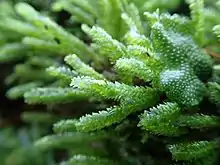Bryology
Bryology (from Greek bryon, a moss, a liverwort) is the branch of botany concerned with the scientific study of bryophytes (mosses, liverworts, and hornworts). Bryologists are people who have an active interest in observing, recording, classifying or researching bryophytes.[1] The field is often studied along with lichenology due to the similar appearance and ecological niche of the two organisms, even though bryophytes and lichens are not classified in the same kingdom.

History
Bryophytes were first studied in detail in the 18th century. The German botanist Johann Jacob Dillenius (1687–1747) was a professor at Oxford and in 1717 produced the work "Reproduction of the ferns and mosses." The beginning of bryology really belongs to the work of Johannes Hedwig, who clarified the reproductive system of mosses (1792, Fundamentum historiae naturalist muscorum) and arranged a taxonomy.
Research
Areas of research include bryophyte taxonomy, bryophytes as bioindicators, DNA sequencing, and the interdependency of bryophytes and other plant, fungal and animal species. Among other things, scientists have discovered parasitic (mycoheterotrophic) bryophytes such as Aneura mirabilis (previously known as Cryptothallus mirabilis) and potentially carnivorous liverworts such as Colura zoophaga and Pleurozia.[2][3][4]
Centers of research in bryology include the University of Bonn in Germany, the University of Helsinki in Finland and the New York Botanical Garden.
Journals
The Bryologist a scientific journal began publication in 1898, and includes articles on all aspects of the biology of mosses, hornworts, liverworts and lichens and also book reviews. It is published by The American Bryological and Lichenological Society.[5][6]
The scientific Journal of Bryology, renamed in 1972 from its original name of Transactions of the British Bryological Society that commenced in 1947, is published by the British Bryological Society.[7]
Notable bryologists
- Miles Joseph Berkeley (1803–1889)
- Elizabeth Gertrude Britton (1858–1934)
- Margaret Sibella Brown (1866–1961)
- Agnes Fry (1869–1957/8)
- Heinrich Christian Funck (1771–1839)
- Robert Kaye Greville (1794–1866)
- Wilhelm Theodor Gümbel (1812–1858)
- Inez M. Haring (1875–1968)
- Hiroshi Inoue (1932–1989)
- Kathleen King (1893–1978)
- Aaron John Sharp (1904–1997)
- Mary S. Taylor (1885-1976)
- Frances Elizabeth Tripp (1832-1890)
- Carl Friedrich Warnstorf (1837–1921)
References
- "Bryology at the New York Botanical Garden". New York Botanical Garden. Retrieved 24 December 2011.
- Wickett, Norman; Goffinet, Bernard (2008). "Origin and relationships of the myco-heterotrophic liverwort Cryptothallus mirabilis Malmb. (Metzgeriales, Marchantiophyta)". Botanical Journal of the Linnean Society. 156 (1): 1–12. doi:10.1111/j.1095-8339.2007.00743.x. Retrieved 23 October 2023.
- Hess, Sebastian; Frahm, Jan-Peter; Theisen, Inge (2005). "Evidence of Zoophagy in a Second Liverwort Species, Pleurozia purpurea". The Bryologist. 108 (2): 212–218. doi:10.1639/6. Retrieved 23 October 2023.
- "Zoophagous Liverworts?". In defence of plants. Retrieved 23 October 2023.
- "The Bryologist on JSTOR". www.jstor.org. Retrieved 22 April 2022.
- "The Bryologist". bioone.org. Retrieved 22 April 2022.
- "Journal of Bryology". Taylor & Francis. Taylor&Francis. Retrieved 23 October 2023.
Literature
- Meylania, Zeitschrift für Bryologie und Lichenologie
- Limprichtia, Zeitschrift der Bryologischen Arbeitsgemeinschaft Deutschlands
External links
- (in German) Bryologie at the University of Bonn
- (in German) A Short History of Bryology
- International Association of Bryologists
- American Bryological and Lichenological Society
- British Bryological Society